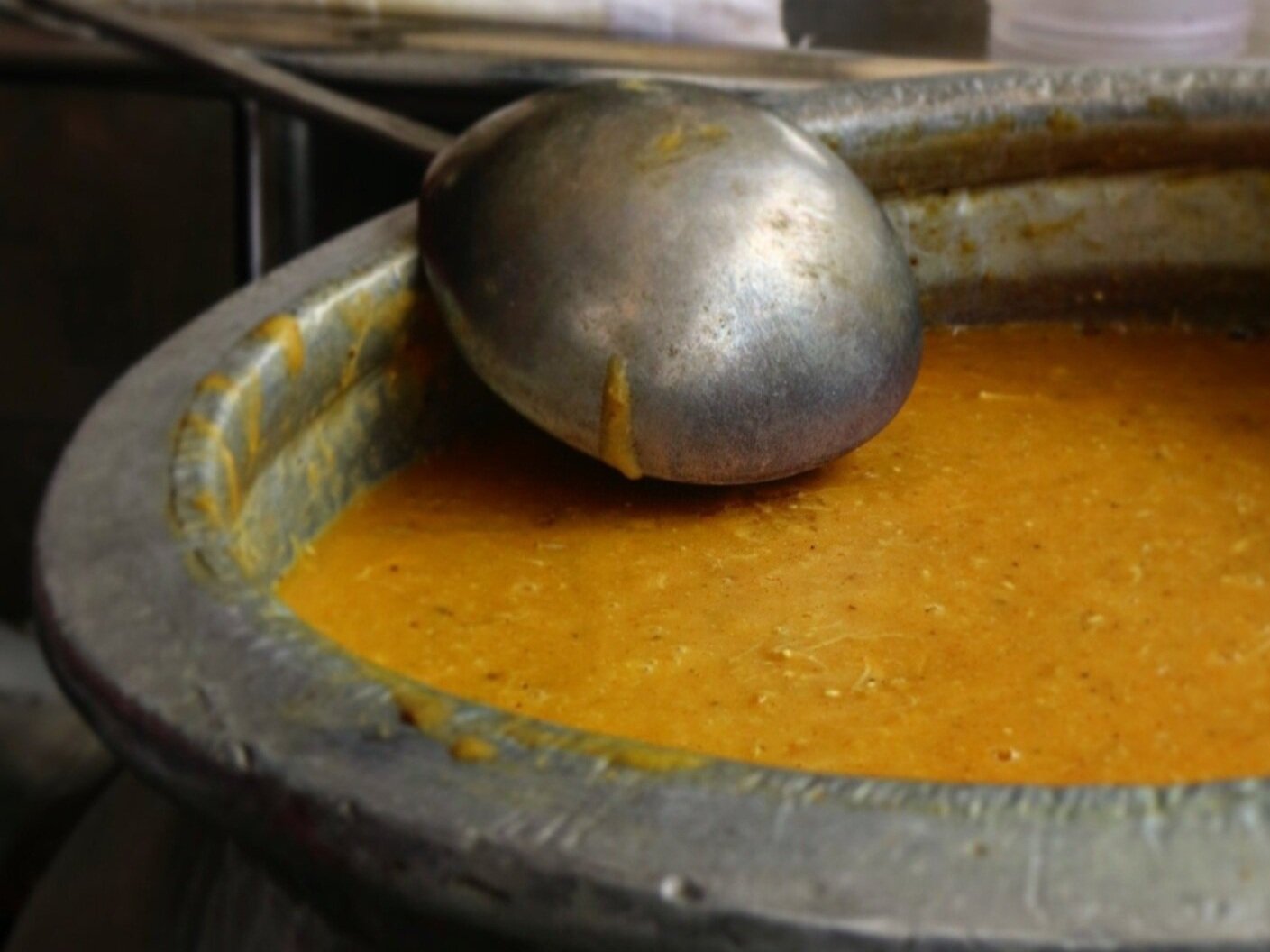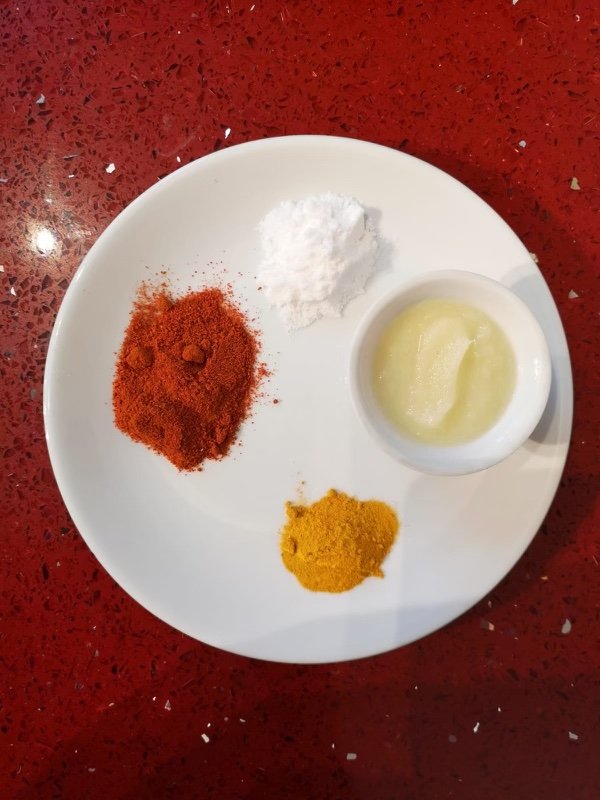Haleem, the gentle stew
Haleem is the ugly delicious kind of cooking. A savoury meat porridge that combines up to seven grains and classic desi spices. It may not be the most visually appealing dish, true, but its beauty reveals itself in the complex and layered flavours. The stew foretells stories of dinner tables across the Middle East through South Asia. The recipe has evolved over hundreds of years, with each cook adding their own flavour and touch, like culinary chinese whispers.
(photo @ridabilgrami Read her blog post, 'Haleem - nourishing mourners in Karachi during Muharram' here)
The roots of Haleem are said to trace back to the Arab 10th century cookbook Kitab Al-Tabikh (Book of Recipes) by Abu Muhammad al-Muzaffar ibn Sayyar. The ancient cookbook compiles the popular dishes eaten by kings and caliphs of Baghdad, and the recipe for Harees, a Middle Eastern dish is strikingly similar to Haleem.
Harees is primarily made up of meat and wheatberries. The stew is said to have travelled across South Asia with Muslim conquerors and soldiers. The influence of local grains, spices and the hands of generations of cooks has led to what we now know as Haleem.
The ingredients for Haleem are humble and while the sheer number may seem overwhelming, they each have a role to play.
The classic grain is wheatberry; the whole wheat kernel (without the husk) is sweet and creamy. It survives the long cooking process with a nut like texture and flavour. My family recipe for Haleem also includes pearl barley to enhance to the grainy chew and bite of the stew. This is unlike the gentle pink Masoor lentil that is the first to soften and disintegrate entirely during the slow cooking. It plays a key role in giving the stew its earthiness and stew consistency.
Mung beans give Haleem its moss green colour, adding to the base woody flavour. White rice plays a role in the creaminess. The creamy Urud or Maash daal, with a mild bitterness, has a slippery thickening nature and further adds to the stew’s structure. And finally, the whole split chickpea, chanaa daal, lends a butteriness to the flavour profile of Haleem.
Unlike the plethora of grains used, the combination of spices is subtle, to give a warm rising heat. Haldi (turmeric) and mirch (red chilli powder) are key. Be gentle on the use of Garam Masala, a heavy hand will leave an unpleasant bitter aftertaste. Sliced white onions, ginger and garlic are added, of course.
Keep it simple.
There is nothing fancy about the cut of meat either. Haleem is classically mutton or beef, although some philistines use chicken (yes I judge!). The rule of thumb is to use double the quantity of meat to the grains. You can use either shoulder or leg but it’s important to cook the meat on the bone as this will add to the flavour. The bones can be removed once the meat is so tender, it has fallen off the bone. It is perfectly acceptable to return the bones in Haleem during service.
Haleem is garnished with raw coriander, julienne ginger and a squeeze of lemon to give freshness. Caramelised slice red onions are sprinkled over the top to lend a sweetness. You can add sliced green chilis to taste. It was slightly controversial of me to drizzle red chilli oil over the top for the purposes of my Haleem photoshoot!
And if you’ve read last month’s issue of Parcha, you know my cooking mantra - let time do its thing, the best is yet to come ;) In fact, while Haleem is delicious after a long day’s cooking, it tastes even better the next day when the flavour has matured.
As the number of ingredients and effort required to cook this stew may indicate, nothing is done in halves with Haleem. The extravagance of the stew extends to the quantity in which you cook the stew itself. The cauldron I use to cook Haleem is the largest one I have in my home, its width taking up all four burners on the stove. I suggest using a cauldron that can take three times the amount of the raw grains combined.
Cooked in such a large amount, Haleem is evidently a dish to be shared (and also to be stowed away in portioned containers in the freezer! More on this as you read on). Unlike Biryani or Nihari, rather than being a dish fit for Mughal and conquerors, I was always brought up to believe Haleem is a dish that instills a sense of community, to bring people together.
The significance of community is evident in the religious folklore intertwined with the cooking of Haleem in Pakistan. Traditionally it is prepared on 10th of Muharam, Ashura, the date on the Islamic calendar signifies the days when Prophet Muhammad’s family were under siege during the Qarbala.
(photo: Haleem-making contest at Hyderabad’s Pista House , Hyderabad, India. The History of Haleem)
The story goes that with limited food and water, everyone drew their grain stock together to cook a shared stew to eat. The resulting stew united the people in their suffering but also their strength. To commemorate this occasion, large cauldrons of Haleem are cooked in Muslim households today, with portions shared with extended family and the less fortunate.
While I can’t personally attest to Haleem’s religious provenance, the ritual of cooking a large meal with the intention to share it with your tribe has unifying quality to it. It’s reassuring to know everyone you have extended the meal to, friends, family and the larger community, are all eating Haleem at the same time. I find this to be an incredible consolation, and it doesn’t surprise me that al Haleem is one of the hundred names of Allah. It comes from the Arab root hilm, connoting to be mild, gentle, calm, serene. Many have encouraged a change of name of the stew to Daleem, but I feel Haleem as a name extends perfectly to the dish’s nature and effect.
This brings me to why Haleem is particularly important to me.
The last time Haleem was cooked in my home was near the end of lockdown. It was actually Ashura and while my family isn’t particularly religious, my mum, in her own act of community comfort, cooked a cauldron of Haleem to mark the occasion.
The summer had been an incredibly challenging one, for personal and professional reasons, and it induced a difficult bout of depression. While I have had my issues with anxiety in the past, the accumulative pain of the challenges I faced (those of which I can’t bring myself to share now) had reduced me to a numb void. For days I lay in bed, crying myself in and out of sleep, with the curtains drawn, unable to eat or talk to anyone.
I’m not sure if my mum realised Haleem was my favourite dish when she decided to cook stew that day. I remember her calling my name from the kitchen, asking if I wanted to take pictures of the cooking process to share on instagram like I had with so much of our cooking over lockdown. But I couldn’t bring myself to get out of bed and I didn’t really see the point of doing anything anymore. And so, without being asked, she did the kindest thing, the sort only a mother does for you. She assembled all the ingredients just as she had seen me do and took pictures of the mise en place. She captured the important stages of the cooking and sent the pictures for me, knowing full well I’d want to share the story of Haleem one day.
I am sharing that story with you now.
I did not eat Haleem that day. I actually ate a portion a few months from then, on a cold November day exactly one year ago. I remember the moment distinctly as I had just run in from the rain and was fretting about not having anything to eat for dinner that evening. I rummaged through the freezer and found a solitary unmarked takeaway box, frozen solid. I decanted the beige cold block in a shallow bowl and shoved it in the microwave to defrost. For two minutes, thirty seconds, I watched the block melt down into its components, first its corners and then slowly towards the centre. The warming grains and silky meat revealed themselves and the soothing smell of the stew permeated my kitchen. I curled up on my armchair, ready to tuck into my bowl of Haleem to warm my bones. Like Proust’s Madeline, each bite took me back, first to those difficult early months of lockdown, then to all the challenges life has presented me over the years. It tapped into my memories of how I made mistakes and I learnt from them. I found my strength, at times on my own, but mainly through the love and support of my loved ones. As with all my weakest moments, I remembered how my friends and family had lifted me up. I recognised the larger community I had created; the support of everyone in London who enjoyed Bun Kabab and those who followed my journey on Empress Market. I could feel the hands of the countless cooks, khansaamas, chefs, nanis, grandmothers and mums who had cooked the stew to comfort their families like a hug in my own bowl of Haleem.
Like Haleem, my story and recipe is humble. My passion to share it with you comes from my meat and bones, but it is my community around me, my tribe that gives my story its depth of flavour. I hope you enjoy it.










